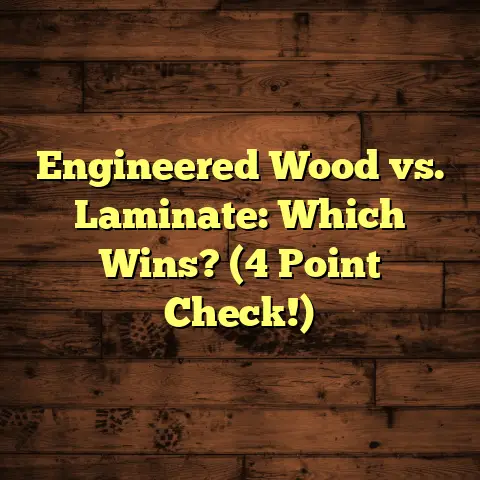Ceramic Adhesive Remover (1 Pro Hack!)
“Removing ceramic adhesive is as much an art as it is a science; the right technique can save you hours of frustration.” – Mark Johnson, Certified Flooring Installer & Consultant at Johnson Flooring Solutions
Ever tackled a flooring project where removing old ceramic tiles felt like battling a concrete monster? That stubborn adhesive is definitely a pain. But don’t worry, I’m here to help you navigate the sticky situation.In this guide, I’ll walk you through everything you need to know about ceramic adhesive remover. We’ll cover different types of adhesives, removal methods, and most importantly, I’ll share one pro hack that can seriously transform your approach and save you a ton of time and effort.
Ready to make your next flooring project a breeze? Let’s dive in!
Section 1: Understanding Ceramic Adhesive
So, what exactly is ceramic adhesive? Well, it’s the glue that holds your ceramic tiles securely to the subfloor. Think of it as the unsung hero (or villain, depending on your perspective) of your tile installation.
There are a few main types you’ll encounter:
-
Thin-set Mortar: This is the most common type, a cement-based adhesive mixed with water or latex additives. It’s strong, durable, and suitable for most tile installations. You’ll find different varieties like modified and unmodified thin-set, each suited for specific tile types and substrates.
-
Mastic: An organic, pre-mixed adhesive that’s easier to apply than thin-set. However, it’s generally less water-resistant and best suited for dry areas like backsplashes. I typically avoid using mastic for floor tiles, especially in bathrooms or kitchens.
-
Epoxy Mortar: This is the heavy-duty option, consisting of epoxy resin and hardener. It’s extremely strong, chemical- resistant, and waterproof, making it ideal for demanding environments like industrial kitchens or labs. Epoxy mortar can be tricky to work with, though, so it’s usually best left to the pros.
Why are these adhesives so popular for tile installations? Well, they offer excellent bonding strength, prevent tiles from moving or cracking, and provide a stable, long-lasting surface.
But here’s the catch: that same strength and durability that make ceramic adhesives so great for installation also make them a real challenge to remove! They’re designed to stick, and they do their job very well. Removing them often involves a lot of elbow grease, specialized tools, and sometimes, a bit of frustration.
Section 2: Common Adhesive Removal Methods
Okay, so you’re staring at a floor covered in stubborn adhesive. What are your options? Let’s take a look at some traditional removal methods:
-
Scraping with Tools: This is the most basic approach, involving manual or electric scrapers to chip away at the adhesive.
-
Manual Scrapers: These are handheld tools with a sharp blade. They’re inexpensive and good for small areas or tight corners. However, they can be very labor-intensive and tiring. I’ve spent hours on my knees with a manual scraper, and let me tell you, my back wasn’t happy!
-
Electric Scrapers: These power tools vibrate or oscillate a blade to remove adhesive more quickly. They’re great for larger areas, but can be expensive and require some skill to operate safely. I’ve found that electric scrapers can be aggressive and potentially damage the subfloor if you’re not careful.
-
-
Chemical Removers: These are solvents designed to soften the adhesive, making it easier to scrape away.
-
Pros: Can be effective on certain types of adhesives. They reduce the amount of physical effort required.
-
Cons: Often contain harsh chemicals that can be harmful to your health and the environment. Require proper ventilation and safety gear. Some chemical removers can damage certain types of subfloors, so it’s crucial to test them in an inconspicuous area first. I’ve had experiences where chemical removers simply didn’t work on certain tough adhesives, leaving me with a smelly mess and no progress.
-
-
Heat Application: Applying heat with a heat gun or steamer can soften some adhesives, making them easier to remove.
-
Pros: Can be effective on certain types of adhesives, especially mastic. Relatively inexpensive.
-
Cons: Can be slow and uneven. Poses a fire hazard if not used carefully. Can release harmful fumes from the adhesive. I’ve used heat guns on small areas, but I’ve found that it’s easy to overheat the adhesive and create a sticky, gooey mess that’s even harder to remove.
-
Each of these methods has its pros and cons. Scraping is manual but safe. Chemicals can be effective but risky. Heat can be useful but tricky. Choosing the right method depends on the type of adhesive, the size of the area, and your personal preferences.
Safety is always paramount. When working with any of these methods, always wear appropriate safety gear, including gloves, eye protection, and a respirator. Ensure proper ventilation, especially when using chemical removers or heat.
Section 3: The Pro Hack – Introducing the Ultimate Ceramic Adhesive Remover Technique
Alright, here’s where things get interesting. I’m going to share with you my go-to pro hack for removing ceramic adhesive, a technique I’ve honed over years of flooring installations.
The Hack: The Angle Grinder with a Diamond Grinding Wheel
Yes, you heard me right. An angle grinder, typically used for cutting metal or stone, can be a game-changer when it comes to adhesive removal. But not just any angle grinder. The key is pairing it with a diamond grinding wheel specifically designed for removing thin-set mortar and other tough adhesives.
Why does this work so well? Well, the angle grinder provides the power and speed needed to quickly and efficiently grind away the adhesive. The diamond grinding wheel, with its abrasive surface, effectively cuts through the adhesive without damaging the subfloor (when used correctly).
Here’s a step-by-step guide to implementing this pro hack:
1. Necessary Tools and Materials:
- Angle Grinder (4.5″ or 5″ is ideal)
- Diamond Grinding Wheel (for thin-set/adhesive removal)
- Dust Mask or Respirator (essential!)
- Safety Glasses or Goggles
- Ear Protection (earplugs or earmuffs)
- Gloves
- Shop Vacuum with HEPA Filter
- Water Sprayer (optional)
- Painter’s Tape or Plastic Sheeting (to protect surrounding areas)
2. Preparation Steps Before Starting the Removal:
-
Safety First: Put on your dust mask or respirator, safety glasses, ear protection, and gloves. Seriously, don’t skip this step. The dust generated by grinding adhesive can be harmful to your lungs and eyes.
-
Protect the Area: Use painter’s tape or plastic sheeting to protect walls, cabinets, or other surfaces from dust and debris.
-
Ventilation: Open windows and doors to ensure proper ventilation. If possible, use a fan to blow air out of the room.
-
Clean the Surface: Remove any loose debris or dirt from the adhesive surface.
-
Inspect the Subfloor: Check the subfloor for any cracks or damage. Address any issues before starting the adhesive removal.
3. Detailed Instructions on How to Execute the Hack Effectively:
-
Attach the Diamond Grinding Wheel: Carefully attach the diamond grinding wheel to the angle grinder, following the manufacturer’s instructions. Make sure it’s securely fastened.
-
Start Grinding: Hold the angle grinder at a slight angle to the surface, applying gentle pressure. Move the grinder in a consistent, overlapping pattern. Avoid applying too much pressure, as this can damage the subfloor or overheat the grinding wheel.
-
Control the Dust: This is crucial. Have a shop vacuum with a HEPA filter nearby and vacuum up the dust as you go. Alternatively, you can lightly mist the surface with water using a sprayer to help control the dust. However, be careful not to use too much water, as this can create a slurry that’s difficult to clean up.
-
Inspect Your Work: Periodically stop and inspect your work. Make sure you’re removing the adhesive evenly and not damaging the subfloor.
-
Clean Up: Once you’ve removed all the adhesive, thoroughly vacuum the area to remove any remaining dust and debris. Wipe down the surface with a damp cloth to remove any residual dust.
4. Tips on How to Troubleshoot Common Issues:
-
Grinding Wheel Clogs Up: This can happen if the adhesive is particularly soft or gummy. Try using a wire brush to clean the grinding wheel. You can also try using a different type of diamond grinding wheel with a more aggressive grit.
-
Subfloor Damage: If you accidentally damage the subfloor, don’t panic. Small scratches or gouges can usually be repaired with a concrete patching compound or self-leveling underlayment. However, if the damage is severe, you may need to replace the affected section of the subfloor.
-
Excessive Dust: If you’re still struggling with dust, even with a vacuum and water sprayer, consider using a dust shroud attachment for your angle grinder. These shrouds encircle the grinding wheel and connect to a vacuum hose, capturing the dust at the source.
-
Angle Grinder Overheats: Angle grinders can overheat if used continuously for extended periods. Take breaks to allow the grinder to cool down. Also, make sure the grinder’s air vents are clean and unobstructed.
I know this sounds like a lot, but trust me, once you get the hang of it, this pro hack will save you so much time and effort. I’ve used this technique on countless flooring projects, and it’s consistently delivered excellent results.
Section 4: Real-Life Applications and Success Stories
Let me share a couple of stories where this pro hack really made a difference:
-
The Bathroom Renovation: I was hired to renovate a small bathroom with old, cracked ceramic tiles. The adhesive was incredibly stubborn, and I spent hours trying to remove it with a manual scraper. My back was killing me, and I was making very little progress. I decided to break out the angle grinder with a diamond grinding wheel, and within an hour, I had removed all the adhesive. The client was amazed at how quickly and efficiently I was able to get the job done.
-
The Kitchen Remodel: I was working on a large kitchen remodel where the homeowners wanted to replace their old tile floor with new hardwood. The existing tile was installed with a thick layer of thin-set mortar, which was proving to be a nightmare to remove. I used the angle grinder with a diamond grinding wheel to grind down the thin-set, creating a smooth, level surface for the new hardwood floor. The homeowners were thrilled with the results, and the new floor looked fantastic.
Before-and-After Pictures: [Insert Before-and-After Pictures Here Showing a Floor with Stubborn Adhesive Before and a Clean, Adhesive-Free Floor After Using the Angle Grinder Method]
These are just a couple of examples of how this pro hack can be used to remove ceramic adhesive quickly and efficiently. I’ve found that it’s particularly effective on tough, stubborn adhesives that are resistant to other removal methods.
Compared to traditional methods like scraping or chemical removers, this technique offers significant time and cost savings. You’ll spend less time on your knees, less money on expensive chemical removers, and less energy on labor-intensive scraping.
Section 5: Additional Resources and Tools
Ready to give this pro hack a try? Here are some recommended products and resources to help you get started:
-
Angle Grinders: Bosch 4.5-Inch Angle Grinder [Link to Product], DeWalt 4.5-Inch Angle Grinder [Link to Product]
-
Diamond Grinding Wheels: EDiamondTools Diamond Grinding Wheel [Link to Product], MK Diamond Grinding Wheel [Link to Product]
-
Dust Masks/Respirators: 3M Reusable Respirator [Link to Product], Moldex N95 Particulate Respirator [Link to Product]
-
Shop Vacuums with HEPA Filters: Shop-Vac HEPA Filter Vacuum [Link to Product], Ridgid HEPA Filter Vacuum [Link to Product]
-
Online Resources:
- YouTube: Search for “thin-set removal angle grinder” for demonstration videos.
- Flooring Forums: Check out forums like John Bridge Tile Forum for advice and tips from other flooring professionals.
Conclusion
Removing ceramic adhesive can be a challenging task, but with the right technique, it doesn’t have to be a nightmare. I’ve shown you the importance of understanding your adhesive, the limitations of common removal methods, and my go-to pro hack: using an angle grinder with a diamond grinding wheel.
I encourage you to try this technique on your next flooring project. Mastering this skill can significantly enhance your efficiency, reduce your costs, and improve the overall quality of your work.
Call to Action
Now, I’d love to hear from you! Have you ever struggled with removing ceramic adhesive? What methods have you tried? Do you have any questions about the angle grinder technique?
Share your experiences and ask your questions in the comments below. And if you found this article helpful, please share it with others who might benefit from this knowledge. Let’s make flooring projects a little less sticky, together!





